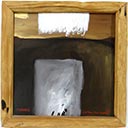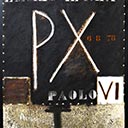E Morto Il Papa
151 x 90 cm
est. $180,000 - 250,000
Provenance
Dr Allan Godfrey Collection
Illustrated: p. 211 Ralph Hotere, Kriselle Baker & Vincent O'Sullivan Ron Sang Publications 2012
At the time of Pope Paul VI's death, Hotere and Cilla McQueen were based in the French town of Avignon, home of the Palais des Papes and former seat of the Catholic popes. In light of this Hotere's Avignon based works appear to convey a message of mourning in response to the death of Pope Paul VI. To an extent, the work does serve this purpose: Emblazoned across the surface of the canvas is a tabloid-type declaration announcing the Pope's death, including his name, and date of death. However, the cultural discourse at play here is considerably more complex, meaning the work belies an intricate religious and historical visual interplay, and therefore serves as much more than a simple memorial painting.
The striking effectiveness of this painting owes much to its aesthetically and formally subversive nature. The flatness of the canvas obscures any sense of space or time, whilst the words "E MORTO IL PAPA" have been branded along a cruciform, much in the style of a pop art slogan. The reference is actually to a newspaper headline which Hotere encountered upon learning of the death of the Pope. In this sense, the work is deeply religious and weaves an intimate dialogue with Hotere's own cultural background, reflected in the finely imprinted whakatauki across the bottom of the painting which reads Ka hinga atu he tetekura, ara mai he tetekura - as one fern frond dies, one is born to take its place.
In this way, Hotere has woven together the centuries old tradition of Catholicism - absorbed first-hand from a place of spiritual and historic significance, and reframed these concerns through a Maori lens, placing his, our, own cultural and national identity as at the forefront.
This visual and conceptual reframing of the Catholic tradition through the artist's own artistic and personal lens is further reflected in the depiction of the Chi Rho symbol, which in its bold and elegant simplicity seems to radiate from the centre of the canvas. This centuries-old christogram, used as a monogram to signify the name of Christ, has been deliberately deconstructed by Hotere. This is technically consistent with his geometric, perspectivally reduced approach to modernism. What is also at play here, is a deeper engagement and deconstruction of these faith traditions, a questioning of sorts in light of the artist's spiritual and geographic immediacy to the recent event of the death of this religious leader.
Religiously symbolism aside, the painting is brilliant in that it offers a syntactical and linguistic synthesis of Greek in the Chi Rho symbol, Italian in the announcement of the Pope's death, Maori in the whakatauki and most significantly, universal concerns in the philosophical breadth, adeptness and adaptability of Hotere's modernist and spiritual concerns.





